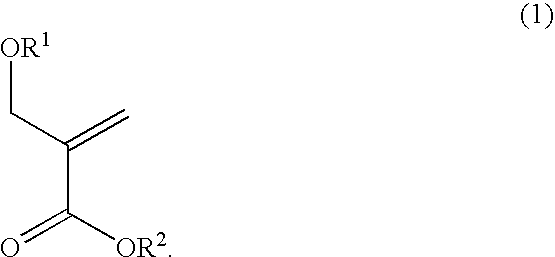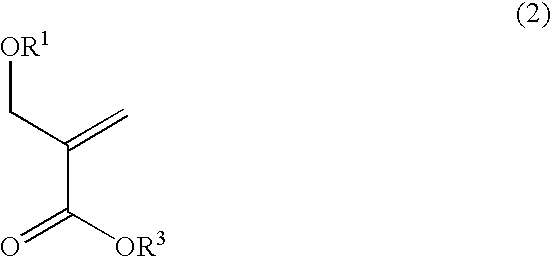Alicyclic methacrylate having oxygen substituent group on alpha-methyl
a technology of oxygen substituent group and alicyclic methacrylate, which is applied in the direction of couplings, instruments, photomechanical equipment, etc., can solve the problems of not meeting all of these requirements, incurring pattern disruption, and not able to withstand etching, so as to improve etching resistance and resolution
- Summary
- Abstract
- Description
- Claims
- Application Information
AI Technical Summary
Benefits of technology
Problems solved by technology
Method used
Image
Examples
example 1
Synthesis of 2,6-norbornanecarbolacton-5-yl α-(hydroxy-methyl)acrylate
[0038]
[0039]118 g of 2,6-norbornanecarbolacton-5-yl acrylate, 31.8 g of 1,4-diazabicyclo[2.2.2]octane, 50.6 g of 37% formalin and 250 g of tetrahydrofuran were combined and stirred for 20 hours. The reaction solution was neutralized with hydrochloric acid, followed by conventional aqueous workup. The solvent was distilled off in vacuo, after which the product was purified by silica gel chromatography, obtaining 81.0 g (yield 60%) of 2,6-norbornanecarbolacton-5-yl α-(hydroxymethyl)acrylate represented by formula (7).
[0040]Results of IR and NMR analyses
[0041]IR (thin film): ν=3479, 2980, 2883, 1782, 1716, 1637, 1452, 1396, 1342, 1308, 1267, 1180, 1163, 1151, 1057, 1043, 1028, 1012, 998, 954 cm−1
[0042]1H-NMR (600 MHz in CDCl3): δ=1.58 (1H, br. d, J=11.6 Hz), 1.69 (1H, br. d, J=13.8 Hz), 1.93 (1H, br. d, J=11.6 Hz), 1.97 (1H, ddd, J=13.7, 11.3, 4.5 Hz), 2.24 (1H, br. s), 2.46–2.52 (2H, m), 3.14 (1H, m), 4.23 (2H, s),...
example 2
Synthesis of 2,6-norbornanecarbolacton-5-yl α-(methoxy-methoxymethyl)acrylate
[0043]
[0044]With stirring, 9.7 g of chloromethyl methyl ether was added to a mixture of 23.8 g of 2,6-norbornanecarbolacton-5-yl α-(hydroxymethyl)acrylate obtained in Example 1, 15.2 g of triethylamine and 200 g of acetonitrile. After 20 hours of stirring, water was added to the reaction solution to stop the reaction. This was followed by conventional aqueous workup. The solvent was distilled off in vacuo, after which the product was purified by silica gel chromatography, obtaining 22.0 g (yield 78%) of 2,6-norbornanecarbolacton-5-yl α-(methoxymethoxymethyl)acrylate represented by formula (8).
example 3
Synthesis of 1-ethylcyclopentyl α-(hydroxymethyl)acrylate
[0045]
[0046]Reaction was performed as in Example 1 except that 95.4 g of 1-ethylcyclopentyl acrylate was used instead of 2,6-norbornanecarbolacton-5-yl acrylate. Purification by vacuum distillation (boiling point 82° C. / 30 Pa) gave 1-ethylcyclopentyl α-(hydroxymethyl)acrylate represented by formula (9). The yield was 68%.
[0047]Results of IR and NMR analyses
[0048]IR (thin film): ν=3466, 2970, 2877, 1707, 1635, 1462, 1392, 1336, 1273, 1227, 1163, 1113, 1055, 949 cm−1
[0049]1H-NMR (600 MHz in CDCl3): δ=0.86 (3H, m), 1.56–1.76 (6H, m), 2.01 (2H, m), 2.14 (2H, m), 2.61 (1H, br), 4.28 (2H, s), 5.74 (1H, m), 6.16 (1H, m)
PUM
| Property | Measurement | Unit |
|---|---|---|
| size | aaaaa | aaaaa |
| temperature | aaaaa | aaaaa |
| temperature | aaaaa | aaaaa |
Abstract
Description
Claims
Application Information
 Login to View More
Login to View More - R&D
- Intellectual Property
- Life Sciences
- Materials
- Tech Scout
- Unparalleled Data Quality
- Higher Quality Content
- 60% Fewer Hallucinations
Browse by: Latest US Patents, China's latest patents, Technical Efficacy Thesaurus, Application Domain, Technology Topic, Popular Technical Reports.
© 2025 PatSnap. All rights reserved.Legal|Privacy policy|Modern Slavery Act Transparency Statement|Sitemap|About US| Contact US: help@patsnap.com



